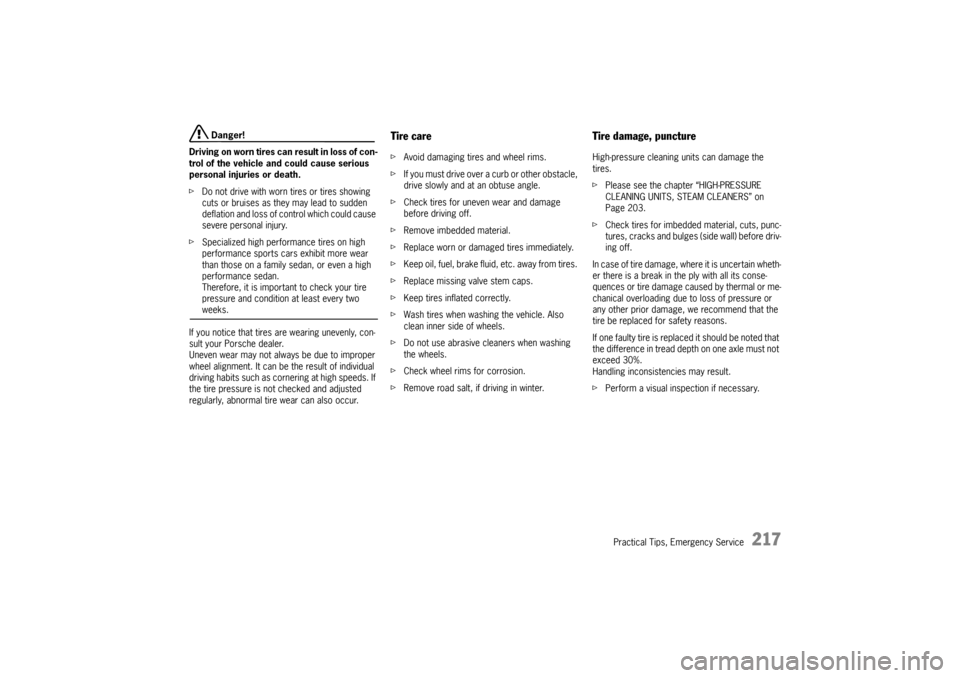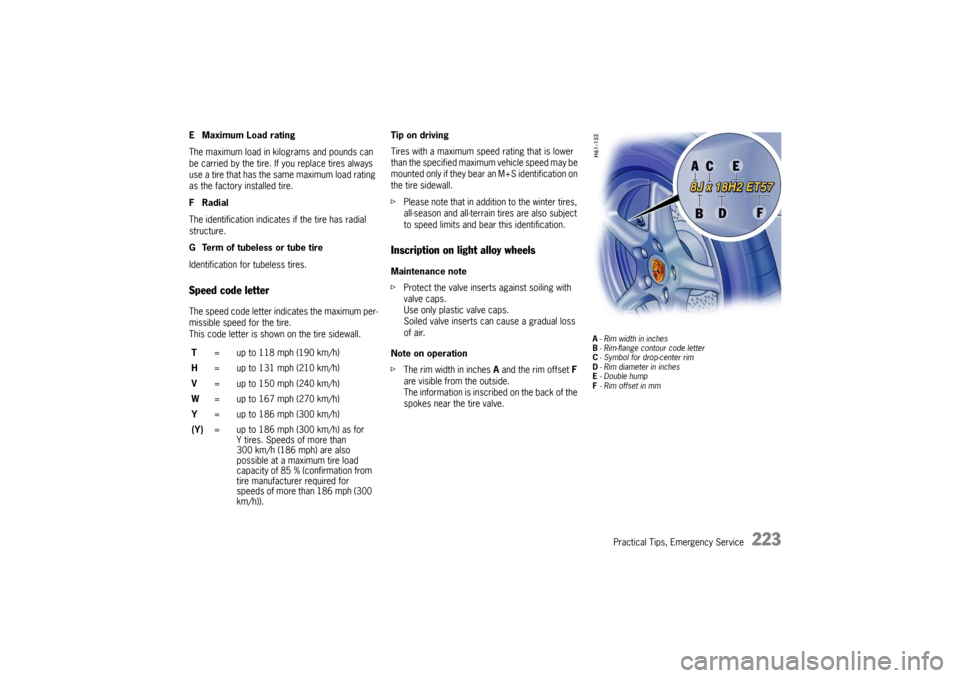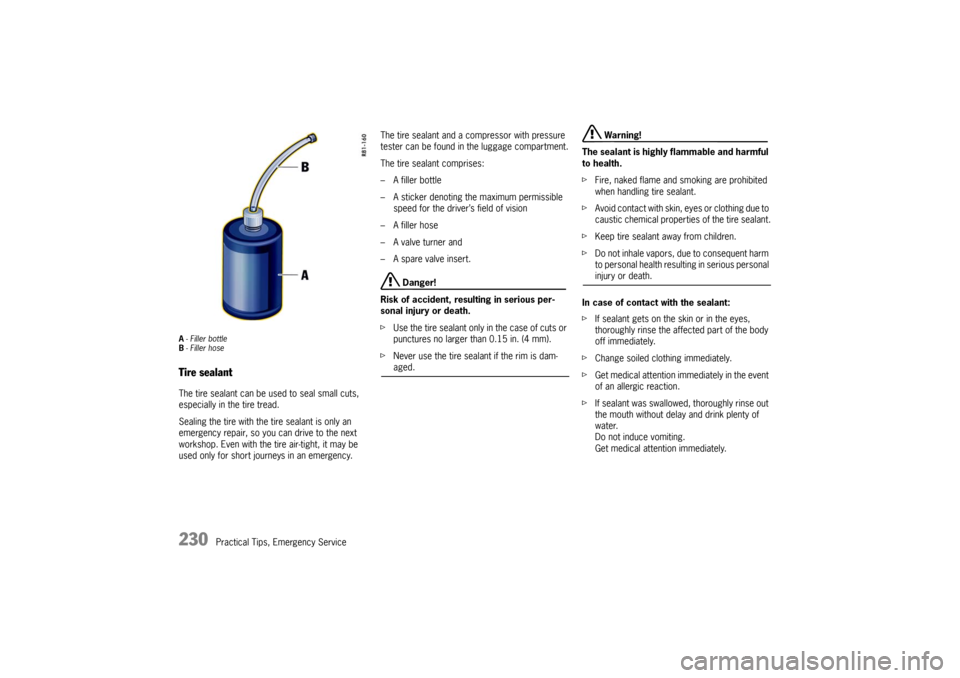2010 PORSCHE CAYMAN oil
[x] Cancel search: oilPage 219 of 284

Practical Tips, Emergency Service
217
Danger!
Driving on worn tires can result in loss of con-
trol of the vehicle an d could cause serious
personal injuries or death.
f Do not drive with worn tires or tires showing
cuts or bruises as they may lead to sudden
deflation and loss of control which could cause
severe personal injury.
f Specialized high performance tires on high
performance sports cars exhibit more wear
than those on a family sedan, or even a high
performance sedan.
Therefore, it is important to check your tire
pressure and condition at least every two weeks.
If you notice that tires are wearing unevenly, con-
sult your Porsche dealer.
Uneven wear may not always be due to improper
wheel alignment. It can be the result of individual
driving habits such as cornering at high speeds. If
the tire pressure is not checked and adjusted
regularly, abnormal tire wear can also occur.
Tire care f Avoid damaging tires and wheel rims.
f If you must drive over a curb or other obstacle,
drive slowly and at an obtuse angle.
f Check tires for uneven wear and damage
before driving off.
f Remove imbedded material.
f Replace worn or damaged tires immediately.
f Keep oil, fuel, brake fluid, etc. away from tires.
f Replace missing valve stem caps.
f Keep tires inflated correctly.
f Wash tires when washing the vehicle. Also
clean inner side of wheels.
f Do not use abrasive cleaners when washing
the wheels.
f Check wheel rims for corrosion.
f Remove road salt, if driving in winter.
Tire damage, puncture High-pressure cleaning units can damage the
tires.
f Please see the chapter “HIGH-PRESSURE
CLEANING UNITS, STEAM CLEANERS” on
Page 203.
f Check tires for imbedded material, cuts, punc-
tures, cracks and bulges (side wall) before driv-
ing off.
In case of tire damage, where it is uncertain wheth-
er there is a break in the ply with all its conse-
quences or tire damage caused by thermal or me-
chanical overloading due to loss of pressure or
any other prior damage, we recommend that the
tire be replaced for safety reasons.
If one faulty tire is replaced it should be noted that
the difference in tread depth on one axle must not
exceed 30%.
Handling inconsistencies may result.
f Perform a visual inspection if necessary.
Page 220 of 284

218
Practical Tips, Emergency Service
Danger!
Risk of serious personal injury or death.
Driving the vehicle with low tire pressure
increases risk of a tire failure and resulting
loss of control. Furthermore, low tire pres-
sure increases rate of wear of the affected
tires.
f Check tires – including sidewalls – regularly for
foreign bodies, nicks, cuts, cracks and bulges.
f After driving off road, examine tires for signs
of damage such as cuts, tears, bulges or for-
eign objects stuck in the tread. Replace a dam-
aged tire if necessary.
f Cross curb edges slowly and at right angles if
possible.
Avoid driving over steep or sharp curbs.
f In cases of doubt, have the wheel (particularly
the inner side) checked by an authorized Porsche dealer.
Tire replacements If in doubt, contact your Porsche dealer.
Use only tire makes and types approved by
Porsche.
If you do not use a Porsche recommended
replacement tire, make sure that you
purchase your new tires from a reputable tire
dealer and that the dealer complies with all
manufacturers warnings for those tires.
Only tires with the same make and with the
same specification code (e.g. “N0”, “N1”...)
can be mounted.
Before mounting new tires, check with your
Porsche dealer about the current release
status.
Use tires with “ZR” quality standards. There
are currently no standards concerning tire
strength at speeds above 150 mph (240 km/h).
Tires should be replaced no less than on one axle
at the time.
Only tires of the same make and type must be
used. Mixed tires are not permissible.
Initially, new tires do not have their full traction.
You should therefore drive at moderate speeds
during the first 60 - 120 miles (100 - 200 km). If new tires are installed only on one axle, a notice-
able change in handling occurs due to the different
tread depth of the other tires.
This happens especially if only rear tires are re-
placed. However, this condition disappears as the
new tires are broken in.
f
Please adjust your driving style accordingly.
Installation of new tires sh ould only be done by a
qualified tire technician.
Valves
Rubber valve stems must be replaced every time
a tire is replaced.
For metal valves, the installation and replacement
instructions must be observed.
f Use only genuine Porsche metal valves.
f Protect the valve inserts against soiling with
valve caps.
Soiled valve inserts can cause a gradual loss
of air.
f Use only plastic valve caps.
Page 225 of 284

Practical Tips, Emergency Service
223
E Maximum Load rating
The maximum load in kilograms and pounds can
be carried by the tire. If you replace tires always
use a tire that has the same maximum load rating
as the factory installed tire.
FRadial
The identification indicates if the tire has radial
structure.
G Term of tubeless or tube tire
Identification for tubeless tires.Speed code letterThe speed code letter indicates the maximum per-
missible speed for the tire.
This code letter is shown on the tire sidewall.Tip on driving
Tires with a maximum speed rating that is lower
than the specified maximum vehicle speed may be
mounted only if they bear an M+S identification on
the tire sidewall.
f
Please note that in addition to the winter tires,
all-season and all-terrain tires are also subject
to speed limits and bear this identification.
Inscription on light alloy wheelsMaintenance note
fProtect the valve inserts against soiling with
valve caps.
Use only plastic valve caps.
Soiled valve inserts can cause a gradual loss
of air.
Note on operation
f The rim width in inches A and the rim offset F
are visible from the outside.
The information is inscri bed on the back of the
spokes near the tire valve.
A - Rim width in inches
B - Rim-flange contour code letter
C - Symbol for drop-center rim
D - Rim diameter in inches
E -Double hump
F - Rim offset in mm
T = up to 118 mph (190 km/h)
H = up to 131 mph (210 km/h)
V = up to 150 mph (240 km/h)
W = up to 167 mph (270 km/h)
Y = up to 186 mph (300 km/h)
(Y) = up to 186 mph (300 km/h) as for
Y tires. Speeds of more than
300 km/h (186 mph) are also
possible at a maximum tire load
capacity of 85 % (confirmation from
tire manufacturer required for
speeds of more than 186 mph (300
km/h)).
Page 232 of 284

230
Practical Tips, Emergency Service
A- Filler bottle
B - Filler hoseTire sealantThe tire sealant can be used to seal small cuts,
especially in the tire tread.
Sealing the tire with the tire sealant is only an
emergency repair, so you can drive to the next
workshop. Even with the tire air-tight, it may be
used only for short journeys in an emergency. The tire sealant and a compressor with pressure
tester can be found in the luggage compartment.
The tire sealant comprises:
– A filler bottle
– A sticker denoting the maximum permissible
speed for the driver’s field of vision
– A filler hose
– A valve turner and
– A spare valve insert.
Danger!
Risk of accident , resulting in serious per-
sonal injury or death.
f Use the tire sealant only in the case of cuts or
punctures no larger than 0.15 in. (4 mm).
f Never use the tire sealant if the rim is dam-aged.
Warning!
The sealant is highly flammable and harmful
to health.
f Fire, naked flame and smoking are prohibited
when handling tire sealant.
f Avoid contact with skin, ey es or clothing due to
caustic chemical properties of the tire sealant.
f Keep tire sealant away from children.
f Do not inhale vapors, due to consequent harm
to personal health resulting in serious personal injury or death.
In case of contact with the sealant:
f If sealant gets on the skin or in the eyes,
thoroughly rinse the affect ed part of the body
off immediately.
f Change soiled clothing immediately.
f Get medical attention immediately in the event
of an allergic reaction.
f If sealant was swallowed, thoroughly rinse out
the mouth without delay an d drink plenty of
water.
Do not induce vomiting.
Get medical attention immediately.
Page 249 of 284

Practical Tips, Emergency Service
247
Bulb chart
Ty p e , r a t i n g
Halogen low beam H7, 55W
Halogen high beam H9, 65W
Low beam/high beam with Bi-Xen on headlights Philips, D2S 35W
Additional high beam with Bi-Xenon headlights H7, 55 W
Turn signal light, front Philips HY21W
Turn signal light, side WY5W
Fog light H8, 35W
License plate light C5W
Lights, Replacing Bulbs
Warning!
Risk of short circuit.
f Always switch off the relevant consumer when
changing bulbs.
Risk of serious personal injury or death.
The Bi-Xenon headlights are under high
voltage when installed.
f Be careful during all work in the area of the Bi-
Xenon headlights.
Risk of damage. Bulbs of a higher wattage
can damage the lamp housing.
f Only the bulbs shown in the chart may be used.
f New bulbs must be clean and free from oil,
grease and fingerprints. Therefore, never
touch bulbs with your bare hands.
Use a cloth or soft paper while replacing bulbs.
Page 268 of 284

266
Technical Data
Technical DataEngine data
CaymanCayman S
Type MA120C MA121C
Horizontally opposed engine, liquid cooled Horizontally opposed engine, liquid cooled
Number of cylinders 6 6
Bore 3.5 in./89 mm 3.8 in./97 mm
Stroke 3.1 in./77.5 mm 3.1 in./77.5 mm
Cubic capacity 176.5 cu. in./2893 cm
3 209.7 cu. in./3436 cm
3
Net-horsepower 265 hp/195 kW 320 hp/235 kW
at crankshaft speed 7200 rpm 7200 rpm
Net torque 221 ft. lb./300 Nm 273 ft. lb./370 Nm
at crankshaft speed 4400 - 6000 rpm 4750 rpm
Engine oil consumption up to 1.6 quarts/622 miles (1.5 liters/1000 km) up to 1.6 quarts/622 m iles (1.5 liters/1000 km)
Page 273 of 284

Technical Data
271
Capacities Use only fluids and fuels authorized by Porsche. Your authorized Porsche dealer will gladly advise you.
Your Porsche has been designed so that it is not necessary to mix any additives with oils or fuels.
Engine Oil change quantity with oil filter approx. 1.98 U.S.gallons/7.5 liters
Please see the chapter “ENGINE OIL RECOMMENDATION” on Page 190.
Coolant Cayman: approx. 6.05 - 6.18 U.S. gallons/22.9 - 23.4 liters
Cayman S: approx. 6.13 - 6.61 U.S. gallons/23.3 - 25 liters
Manual transmission and differential Cayman: approx. 0.79 U.S. gallons/3 liters
Cayman S: approx. 0.85 U.S. gallons/3.2 liters
Porsche Doppelkupplung
Gear set approx. 0.78 U.S. gallons/2.95 liters
Porsche Doppelkupplung
Clutch/Hydraulic fluid approx. 1.37 U.S. gallons/5.2 liters
Power steering approx. 1.1 quarts/1 liter hydraulic fluid Pentosin CHF 11 S
® or CHF 202 S
®
Brake fluidapprox. 0.4 quarts/0.39 liters; use
only Original Porsche brake fluid
Windshield washer approx. 0.66 U.S. gallons/2.5 liters without headlight washer
approx. 1.58 U.S. gallons/6 liters with headlight washer
Fuel tank Refill volume approx. 16.9 U.S. gallons/64 liters, including approx. 2.6 U.S.gallons/10 liters reserve.
Fuel quality Your engine is designed to provide optimum performance and fuel economy using unleaded premium fuel with
an octane rating of 98 RON (93 CLC or AKI).
Porsche therefore recommends the use of these fuels in your vehicle.
Porsche also recognizes that these fuels may not always be available. Be assured tha t your vehicle will operate
properly on unleaded premium fuels with octane numbers of at least 95 RON (90 CLC or AKI), since the engine’s
”Electronic Octane™ knock control“ will adapt the ignition timing, if necessary.
Page 278 of 284

276
Index
CCapacities, overview ................................... 271
Car care ........................ ............................ 203
Car telephone ............. ................................ 103
Car washes .................... ............................ 204
Cargo partition ........... .................................. 97
Carpet ....................................................... 209
Catalytic converters .... ................................ 199
Cautions ........................ .................... 186, 212
Central locking ........... ................................ 236
Emergency operation ...................... 19, 22
In cars with alarm system ...................... 21
In cars without alar m system ................. 19
Overload protection ............................ 236
Central vents .............. ................................ 116
Central warning light ................................... 132
Changing light-emitting diodes (LEDs) ........... 256
Changing wheels ........ ................................ 227
Check engine Warning light .......... ............................ 132
Check engine warning li ght .......................... 133
Opening the oil filler cap ...................... 189
Checking pressure ...... ................................ 228
Child restraint anchor age .............................. 54
Child restraint system s.................................. 50
Chime ............... ......................... ............ 78, 80
CHRONO Stopwatch.... ................................ 144
Cigarette lighter.......... .................................. 90
Circulating-air button ... ........................ 110, 114
Clock ............................................. .... 131, 164
Clutch ............... ............................. ...... 60, 176
Clutch pedal ............... .................................. 60
Combination filter ....... ................................ 201
Comfort seat .............. .................................. 33 Coming home mode ......
.......................... 79, 80
Communication manage ment ....................... 101
Compact disc
Player ...................... .......................... 102
Storage .................... ............................ 92
Compartment monitoring ................ ............... 25
Coolant ........... ........................... 128, 187, 271
Checking ............................................ 187
Level .................................................. 187
Temperature gage .... ..........................1
28
Topping off ........... .............................. 187
Warning light......... .............................. 128
Cooling system ............. ...................... 128, 187
Warning light......... .............................. 128
Cornering light .......... .................................... 78
Indicator light ........ .............................. 127
Crankcase ventilation .................................. 199
Cruise control ................................. 86, 87, 132
Cupholder ......................................... ........... 88
DData bank................................................... 264
Daytime driving lights .................................... 78
Changing bulbs ..... .............................. 256
On-board computer ............................. 164
Defrosting windows ....... ................ 31, 110, 114
Diagnostic socket ..... .................................... 11
Dimensions ....................................... ......... 272
Direction indicator lig ht, front ....................... 256
Door ............................ ................................ 18
Handles ................................................ 18
Locks....................... .................... 18, 205
Mirror....................... ............................ 30
Mirror heating ....... ................................ 31 Mirrors ....................
.............................29
Windows ...................... ...........18, 27, 206
Drive-Off Assistant ....... ................................177
Driving Hints .............. ........................................8
Winter ......................... .......................183
Driving off Drive-Off Assistant .... ...........................177
Launch Control......... ...........................181
Driving performance .... ................................270
Drop-center rim........... ................................223
EElectrical system..... ....................................235
Emergency flasher swit ch ..............................77
Emergency operation . ...................................22
Central locking ......... .......................19, 22
Ignition key ......... ..................................74
Lids................ ......................... ...........238
Tank flap ................. ...........................195
Emergency service ..... ................................212
Emergency starting with jumper cables.245, 246
Emission control system ..............133, 198, 199
Engine Checking the oil leve l ...........................161
Diagram ...................... .......................273
Exhaust ................... ...............................5
Number ..............................................265
Oil consumption ....... .....................10, 188
Oil level ................... ...........................189
Oil level indicator ...................... ...........161
Oils ............................................188, 271
Speeds.................... .............................10
Starting ................................................75